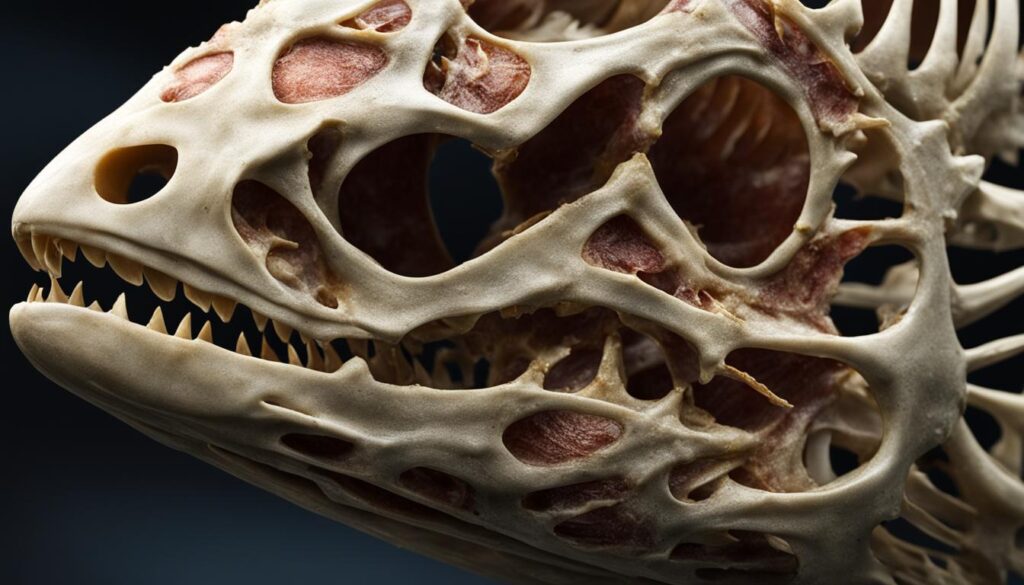Hello, fellow dog owners! I’m here to shed some light on a common question: Can dogs eat fish sticks? While dogs can enjoy the nutritional benefits of fish, it’s essential to be cautious when it comes to feeding them fish sticks. In this article, I’ll provide you with pet safety tips and advice on the appropriate fish sticks for dogs.
Before making any dietary changes for your furry friend, it’s always a good idea to consult with your veterinarian. Factors such as age, health history, and dietary needs can impact whether fish sticks are safe for your dog. Additionally, it’s crucial to consider the ingredients in fish sticks, as some may contain harmful additives or breading that can upset your dog’s stomach.
Key Takeaways:
- It’s important to check with your veterinarian before introducing fish sticks or any new food into your dog’s diet.
- Consider your dog’s age, health history, and dietary needs when deciding if fish sticks are appropriate for them.
- Some fish sticks may contain additives or breading that can upset your dog’s stomach.
- Fish can be a nutritious addition to a dog’s diet, providing protein and omega-3 fatty acids for a healthy coat and skin.
- When feeding fish sticks to dogs, it’s crucial to choose the right type of fish and properly cook it to ensure safety and health.
The Benefits of Fish for Dogs
Fish can be a nutritious addition to your dog’s diet. It is a great source of protein and contains omega-3 fatty acids, which are important for a healthy coat and skin.
Protein is a crucial nutrient for dogs as it supports muscle development, helps repair tissues, and supports a strong immune system. Fish, such as salmon or whitefish, is a high-quality protein source that can provide your dog with essential amino acids.
The omega-3 fatty acids found in fish have numerous health benefits for dogs. They promote a healthy coat and skin, reduce inflammation, and support brain development. Omega-3 fatty acids can also improve joint health and alleviate symptoms associated with arthritis or other joint conditions.
Adding fish to your dog’s diet can be especially beneficial for dogs with food allergies. Fish is considered a novel protein, meaning it is less likely to cause an allergic reaction in dogs who have sensitivities to more common proteins, such as beef or chicken.
Furthermore, fish collagen, which is found in the skin of fish, offers additional benefits for dogs. Collagen promotes joint health, supports bone strength, and helps maintain healthy skin. This can be particularly beneficial for senior dogs who may experience age-related joint issues or skin problems.
To ensure the safety and health of your dog, it is important to choose the right type of fish and prepare it properly. Opt for fish that are low in mercury and avoid fish with small bones that could pose a choking hazard. Additionally, ensure that the fish is thoroughly cooked to eliminate the risk of parasitic infections.
Types of Fish Safe for Dogs

When it comes to choosing fish sticks for your canine companion, it’s important to prioritize their safety and well-being. Smaller, younger, wild-caught fish are generally considered safe options for dogs. Two types of fish that can be fed to dogs are sardines and tilapia.
Sardines
Sardines are a popular choice for dogs due to their small size and nutritional benefits. They are a rich source of omega-3 fatty acids, which support a healthy coat and skin. Additionally, sardines provide protein and can serve as a novel protein source for dogs with food allergies.
Tilapia
Tilapia is another fish option that can be included in your dog’s diet. It is a low-calorie and protein-rich fish, making it suitable for dogs on a weight management plan. However, it’s important to cook tilapia thoroughly and remove any bones before offering it to your dog.
When feeding your dog fish sticks, it’s crucial to properly clean and cook the fish to eliminate any potential bacteria or parasites. It’s also recommended to avoid larger fish species, such as shark, swordfish, and king mackerel, as they may contain higher levels of mercury and parasites that could be harmful to your dog’s health.
| Type of Fish | Key Benefits |
|---|---|
| Sardines | – Small size suitable for dogs – Rich in omega-3 fatty acids – Can be a novel protein source for dogs with allergies |
| Tilapia | – Low in calories – High in protein – Suitable for dogs on weight management plans |
Remember, always consult with your veterinarian before making any changes to your dog’s diet or introducing new foods. They will be able to provide personalized recommendations based on your dog’s specific needs and health conditions.
Risks of Feeding Fish Sticks to Dogs

While fish itself is not harmful to dogs, there are risks associated with feeding them fish sticks.
The breading used in fish sticks may contain oils, fats, salts, and empty calories that can upset your dog’s stomach or even lead to pancreatitis. Additionally, the bones in fish sticks can be a choking hazard or cause injuries if swallowed.
It is important to choose fish sticks with minimal additives and to avoid feeding them to your dog.
| Risks of Feeding Fish Sticks to Dogs |
|---|
| Breading containing oils, fats, salts, and empty calories can upset the dog’s stomach or lead to pancreatitis. |
| Bones in fish sticks can pose a choking hazard or cause injuries if swallowed. |
| Choose fish sticks with minimal additives to reduce the risk. |
Can Dogs Eat Raw Fish Sticks?

Raw fish sticks are not recommended for dogs according to the American Veterinary Medical Association. Feeding your dog raw or undercooked fish sticks can pose several health risks. Raw fish sticks can harbor parasites and bacterial organisms such as salmonella and listeria, which can be harmful to both dogs and humans.
To ensure the safety and health of your dog, it is important to cook fish sticks thoroughly before feeding them. Cooking fish sticks kills any potential parasites or bacteria, reducing the risk of infections or illnesses. By cooking fish sticks, you can provide a safer and more nutritious option for your canine companion.
When preparing fish sticks for your dog, it is essential to follow proper cooking methods, such as baking or frying, to ensure they are fully cooked. Avoid feeding your dog partially cooked or raw fish sticks, as this increases the risk of foodborne illnesses.
“Feeding your dog raw fish sticks can expose them to harmful bacteria and parasites. It is crucial to prioritize their health and well-being by cooking fish sticks thoroughly before offering them as a treat.”
Properly cooked fish sticks offer a delicious and safe option for your dog to enjoy. They can provide essential nutrients such as protein and omega-3 fatty acids, which promote a healthy coat and skin. However, always consult with your veterinarian before introducing any new foods into your dog’s diet, including cooked fish sticks.
Benefits of Cooking Fish Sticks for Dogs:
- Eliminates the risk of parasites and bacteria.
- Ensures the fish sticks are fully cooked and safe for consumption.
- Preserves the nutritional value of the fish sticks.
- Makes the fish sticks more easily digestible for dogs.
To get a better understanding, take a look at the table below that highlights the key differences between raw and cooked fish sticks for dogs:
| Raw Fish Sticks | Cooked Fish Sticks | |
|---|---|---|
| Safety | Potential for harmful bacteria and parasites. | Eliminates bacteria and parasites through cooking. |
| Nutritional Value | May contain beneficial nutrients but may also pose a risk of bacterial infection. | Retains nutritional value, including protein and omega-3 fatty acids. |
| Digestibility | May be less digestible for dogs, increasing the risk of stomach upset. | More easily digestible for dogs, reducing the risk of gastrointestinal issues. |
How to Cook Fish Sticks for Dogs

When it comes to preparing fish sticks for dogs, it is essential to follow proper cooking methods to ensure their safety and well-being. Here are some guidelines to help you prepare fish sticks that are safe and suitable for your furry friend:
- Cook the fish sticks according to the instructions provided on the packaging. This will ensure that they are fully cooked and free from any potential bacteria or parasites that could be harmful to your dog.
- Avoid adding any oils, seasonings, or additives to the fish sticks. While flavors may be tempting, certain ingredients can be harmful to dogs. Stick to plain, cooked fish sticks to keep them safe.
- Remove any breading that may contain corn or wheat. These ingredients can be difficult for some dogs to digest and may cause sensitivities or allergies. It’s best to err on the side of caution and remove the breading before serving.
Remember, every dog is unique, and their dietary needs may vary. It is always wise to consult with your veterinarian for specific guidance on cooking fish sticks for your dog. They can provide tailored advice based on your dog’s health, age, and individual needs.
By following these steps, you can ensure that the fish sticks you serve to your dog are safe, healthy, and enjoyable. Your furry companion will appreciate the delicious treat, and you’ll have peace of mind knowing that you’ve taken the necessary precautions.
Fish Skin, Bones, and Other Considerations

When it comes to feeding fish to dogs, it’s important to consider the safety of fish skin and bones. While fish itself can be a nutritious addition to your dog’s diet, there are certain precautions you should take to ensure their well-being.
Uncooked Fish Skin and Its Risks
Uncooked fish skin should not be given to dogs as it can transmit parasites and bacteria that may cause health issues. It’s essential to cook fish thoroughly to eliminate any potential risks. However, if you’re looking for a tasty treat for your canine companion, there are dried fish skin treats available on the market. Make sure to choose treats that are prepared without oils or seasonings to ensure the safety of your dog.
Avoid Feeding Fish Bones to Dogs
Fish bones, including the head, tail, and fins, pose significant risks when fed to dogs. They can create choking hazards or cause injuries to the digestive tract. It’s crucial to remove all bones from fish before feeding it to your dog. Carefully clean, debone, and fillet fresh-caught fish to eliminate any potential dangers associated with fish bones.
Can Puppies or Pregnant Dogs Eat Fish Sticks?

Puppies and pregnant dogs can safely consume fish sticks, but it is important to take precautions. Fresh fish sticks should be properly cleaned, deboned, and cooked thoroughly before offering them to puppies or pregnant dogs. Light canned tuna may also be offered in addition to a commercially available dog food. It is always advisable to consult with a veterinarian before introducing fish sticks or any new food to puppies or pregnant dogs.
| Fish Sticks for Puppies and Pregnant Dogs | Safety Precautions |
|---|---|
| 1. Fresh fish sticks | – Clean and remove bones |
| 2. Light canned tuna | – Offer with commercial dog food |
| 3. Consult a veterinarian | – Ensure suitability for puppies and pregnant dogs |
How Much Fish Sticks Can Dogs Eat?
The portion size of fish sticks for dogs depends on their nutritional needs, weight, and overall health. In general, fish sticks can be offered as an occasional treat or dietary supplement several times a week. It is important to consider the appropriate portion sizes to maintain a balanced diet for your furry friend.
When determining the portion size of fish sticks for dogs, it is crucial to take into account their size and calorie requirements. For extra-small dogs, a single small square of fish stick can be sufficient. Small to medium-sized dogs may benefit from one to two small squares of fish stick. Medium to large dogs can be given two to three small squares or one large square. It is essential to adjust the portion size accordingly to meet the specific needs of your dog.
To ensure the health and well-being of your canine companion, it is recommended to consult with your veterinarian for individual feeding guidelines. They can provide you with personalized recommendations based on factors such as your dog’s breed, age, weight, and any underlying health conditions.
| Dog Size | Portion Size of Fish Sticks |
|---|---|
| Extra-Small Dogs | 1 small square |
| Small to Medium-sized Dogs | 1-2 small squares |
| Medium to Large Dogs | 2-3 small squares or 1 large square |
Adding Fish Sticks to Your Dog’s Diet
Fish sticks can be a delightful addition to your dog’s diet, whether as a special treat or a dietary supplement. They can be incorporated into your dog’s meals in various ways, depending on their nutritional needs and preferences.
If you prefer the convenience of commercially available dog food, look for brands that offer nutritionally balanced options containing fish sticks. These dog foods are specifically formulated to provide all the necessary nutrients, vitamins, and minerals that your dog needs, while also including the delicious goodness of fish sticks. This ensures that your furry friend can enjoy the benefits of fish without compromising their overall nutritional balance.
On the other hand, if you prefer to prepare homemade meals for your dog, you can include fish sticks in their diet as well. It is important to ensure that you provide a balanced and complete meal that meets your dog’s specific dietary requirements. Consulting with a veterinary nutritionist can be immensely helpful in creating a diet plan tailored to your dog’s individual needs.
When incorporating fish sticks into a homemade diet, it is crucial to ensure that you include all the necessary nutrients. Fish sticks can provide an excellent source of protein, omega-3 fatty acids, and other essential nutrients for your dog’s overall health. However, it is important to remember that fish sticks should not be the sole source of nutrition.
A diet that includes a variety of ingredients, such as lean meats, fruits, vegetables, and grains, along with fish sticks, can help maintain a balanced diet for your dog. Avoid overfeeding fish sticks, as they may contain additional ingredients, such as breading or seasonings, that may not be suitable for dogs in large quantities.
By incorporating fish sticks into your dog’s diet, you can provide them with a unique and tasty culinary experience. Just remember to prioritize the nutritional needs of your furry friend and consult with a professional to ensure that their diet remains well-balanced and healthy.
Example Balanced Diet for Dogs with Fish Sticks:
| Meal | Ingredients |
|---|---|
| Breakfast |
|
| Lunch |
|
| Dinner |
|
Note: This is a general example and should be adjusted based on your dog’s size, activity level, and specific nutritional requirements. Always consult with a veterinarian or veterinary nutritionist for personalized meal plans.
Wrapping Up
Can dogs eat fish sticks? While dogs can safely consume fish, it is important to exercise caution when it comes to feeding them fish sticks. Always prioritize the wellbeing of your furry friend by consulting with a veterinarian before introducing new foods into their diet. Consider the type of fish used, the cooking methods employed, and the potential risks associated with fish sticks.
When choosing fish sticks for your dog, opt for those with minimal additives and avoid feeding them to your pet if they contain harmful ingredients. It is crucial to prepare fish sticks properly, taking your dog’s individual needs and health conditions into account. By following these pet safety tips and guidelines, you can ensure that your dog enjoys fish sticks in a safe and healthy manner.
In summary, while fish sticks can be an occasional treat or dietary supplement for dogs, it is essential to prioritize their health and well-being. Consult with your veterinarian, choose fish sticks with care, and prepare them properly. By doing so, you can incorporate fish sticks into your dog’s diet in a way that maintains their safety and promotes their overall health.
FAQ
Can dogs eat fish sticks?
It is important to be cautious when feeding dogs fish sticks. Always check with your veterinarian before introducing any new food into your dog’s diet.
Are fish sticks safe for dogs?
Fish sticks may contain harmful additives or breading that can upset a dog’s stomach. It is important to choose fish sticks with minimal additives and to avoid feeding them to your dog if they contain harmful ingredients.
What are the benefits of fish for dogs?
Fish is a great source of protein and contains omega-3 fatty acids, which are important for a healthy coat and skin. It can also provide a novel protein source for dogs with food allergies and support bone and skin health in senior dogs.
What types of fish are safe for dogs?
Smaller, younger, wild-caught fish such as sardines and tilapia can be safe options for dogs. It is important to properly clean and cook the fish before feeding it to your dog.
What are the risks of feeding fish sticks to dogs?
Fish stick breading may contain oils, fats, salts, and empty calories that can upset a dog’s stomach or lead to pancreatitis. The bones in fish sticks can also be a choking hazard or cause injuries if swallowed.
Can dogs eat raw fish sticks?
The American Veterinary Medical Association does not recommend feeding dogs raw or undercooked fish sticks. Raw fish sticks can harbor and transmit parasites and bacterial organisms that can be harmful to dogs and humans.
How should fish sticks be cooked for dogs?
Fish sticks should be cooked thoroughly to ensure the safety and health of dogs. Follow proper preparation methods and avoid using additional oils, seasonings, or additives that could be harmful to dogs.
Can dogs eat fish skin and bones?
Uncooked fish skin is not safe for dogs to consume, as it can transmit parasites and bacteria. Fish bones should also not be fed to dogs, as they can cause choking hazards and injuries to the digestive tract.
Can puppies or pregnant dogs eat fish sticks?
Puppies and pregnant dogs can safely consume fish sticks, but it is important to take precautions. Fresh fish sticks should be properly cleaned, deboned, and cooked thoroughly before offering them to puppies or pregnant dogs.
How much fish sticks can dogs eat?
The portion size of fish sticks for dogs depends on their nutritional needs, weight, and overall health. It is always advisable to consult with a veterinarian for guidance on the appropriate amount of fish sticks for a dog’s diet.
Can fish sticks be added to a dog’s diet?
Fish sticks can be added to a dog’s diet as a special treat or dietary supplement. They can be included in a commercially available, nutritionally balanced dog food or as part of a home-cooked diet.






